Functions of Film Sound: The Prestige
excerpt from Film Art: An Introduction, 10th edition, McGraw-Hill (2012): 298–306
In London around 1900, two magicians are locked in desperate competition, each searching for ever more baffling illusions. As they deceive each other and their audiences, the film about them tries to deceive us as well.
A story of crime, professional rivalry, personal jealousy, and grand aspirations, The Prestige sets itself a difficult task. The film tries to be as tantalizing as a magic trick, but one that can eventually be explained. As a result, director Christopher Nolan and his screenwriter (and brother) Jonathan Nolan must both reveal and conceal information. The film must present us just enough of the story to keep us engaged, while holding back the answers to the puzzles—and sometimes, like a magician, distracting us from what is really going on. Throughout The Prestige, sound is crucial to an elaborate choreography of misdirection.
Transported Men
The conflict between the eager Robert Angier (Hugh Jackman) and the more sinister Alfred Borden (Christian Bale) begins when both are apprentice magicians. Robert’s wife, Julia, dies in an immersion tank as a result of Borden’s faulty rope-knot. As the two men grow in fame, their feud escalates. Robert shoots off two of Alfred’s fingers in a botched “bullet catch.” In response, Alfred sabotages one of Robert’s illusions. Then Alfred mounts an amazing trick, the Transported Man. Alfred seems to disappear from one end of the stage and reappear instantly at the other. In retaliation, Robert finds a man who resembles him and creates a similar illusion. But Alfred unmasks the stunt, breaking Robert’s leg and humiliating him before his audience.
Robert vows to find the secret behind Alfred’s Transported Man. After consulting with Nicola Tesla, the great experimenter with electricity, Robert returns to London with a stunning new illusion. He stands onstage in a crackling field of lightning bolts and disappears, reappearing a few seconds later in the balcony. Alfred, usually quick to unravel a trick, is baffled. He resigns himself to quitting the trade. Nonetheless, he shows up in disguise at one of Robert’s performances and penetrates the area below stage. At the climax of the trick, Alfred sees Robert fall through a trapdoor into a tank of water below. He watches Robert drown. Alfred is arrested for murder and condemned to death.
At the climax of the film, Alfred’s original Transported Man illusion is revealed as a simple trick: There are two Bordens, identical twins. At any moment, one takes the Alfred identity, while the other is disguised as Fallon, Alfred’s designer of illusions or ingénieur. So when one Borden twin does change his mind about quitting magic, the other obstinately attends Robert’s performance. As a result, while one Alfred is hanged, the other can stalk Robert for a final act of revenge.
Somewhat earlier, and more gradually, we learn that Robert’s version of the Transported Man is no illusion but rather super-science. Tesla has created a cloning machine, which makes an identical copy of Robert and deposits that at some distance from the original. At every performance, one Robert falls through the trapdoor and into a waiting tank, where he drowns. The reconstituted, identical Robert, dispatched elsewhere in the theater, takes the crowd’s applause—only to be sacrificed under the stage the following night.
The rising conflict between Robert and Alfred reveals contrasting aspects of each man’s personality. Robert is a smooth showman, one whose highest goal is to amaze an audience. Alfred, less concerned with ornate effects, builds his original Transported Man illusion out of two simple doors and a child’s red ball. He believes that a magician has a duty to come up with the most baffling trick possible, one that will puzzle not just the public but other professionals. To achieve that, the magician should be prepared to “live his act,” to give up a full personal life if that helps him to purify his art. So when one Borden brother loses two fingers to the bullet catch, his twin must slice off his own fingers to continue their charade.
Gradually, the personalities of Robert and Alfred move closer together, and our sympathies shift. At first Robert’s love of magic is sensibly balanced by his love for Julia. Her death increases our sense that Alfred is treacherous and Robert a victim. But as Robert launches an all-out effort to destroy his rival, he comes to seem possessed. Both Tesla and Robert’s ingénieur Cutter warn him that he is becoming obsessive. At the other pole, one of the Borden twins falls in love with Sarah, a young governess. He risks giving his secret away in order to have something like a normal life with her and their daughter Jess. The other, more cynical twin takes up an affair with Olivia, who becomes the act’s assistant. The price of finding a woman to love is that sometimes one twin must stand in for the other. These substitutions create emotional disruptions that each woman detects. To the art of magic, the two Alfreds sacrifice not only themselves but also their loved ones.
The Sounds of Magic
The basic story of The Prestige is complicated, but it could have been presented in linear order, letting us in on secrets behind the illusions. The plot might have made Robert the protagonist, withholding the information about Alfred’s personal and professional life that Robert never learns. Alternatively, the plot could have stuck to Alfred’s range of knowledge and shown the Borden twins pulling off their stratagems. (David Cronenberg’s Dead Ringers provides a rough example.) Instead, The Prestige wants to mystify us as much as the illusions mystify the magicians and their audiences. The competing magicians are driven by curiosity about how the tricks are done, and this curiosity is central to our experience as well.
Accordingly, the story is presented via unrestricted narration, but it is manipulated through many techniques of plot construction. The plot shuffles story order, plays with levels of knowledge, replays some scenes, and cuts off others, withholding their consequences. Yet these maneuvers don’t confuse us about the basic story progression. They arouse curiosity (what has led up to this turn of events?) and suspense (what will happen next?). At the same time, the plot misdirects our attention, suppressing key information about the magicians’ secrets.
The overall dramatic progression is framed by present-time action, that of the climactic performance of Robert’s Tesla-driven illusion. This stage spectacle leads to one of the Borden twins being arrested, condemned, and hanged for the death of one Robert in his below-stage tank. The other Alfred faces Robert one last time. Most of the plot consists of layered flashbacks showing different stages of the two men’s struggle. Our understanding is eased by the fact that most of the story strands are presented chronologically, as in Citizen Kane (pp. 101–102). In addition, the basic conflict is maintained through familiar means—scenes of confrontation, or backstage plotting, or confidences shared between the protagonists and their families and friends. Occasionally, there are personalized flashbacks illustrating what a character is recalling, as when in prison Alfred remembers his romance with Sarah. And when the second Alfred confronts the clone Robert at the climax, a series of more impersonal flashbacks shows us what was really happening in scenes we thought we understood.
Along with visual techniques, sound choices help smooth our understanding of the ongoing action. Characters are differentiated through their voices, especially the contrast between Alfred’s London working-class accent and Robert’s American accent (which turns out to be fake). A sketchy piano motif in the score is associated with Alfred’s life with his wife and child. Each locale has its characteristic ambience—the prison with distant scuffling and slamming, the less cavernous echo of the warehouse that becomes Robert’s workshop, the warmer sound of the theaters, the crunching snow surrounding Tesla’s compound in Colorado.
“With The Prestige I was using electronics to achieve effects I couldn’t get with the orchestra.… There’s a lot of stuff in tracks such as ‘Colorado Springs’ where in the background there is a Shepard’s Tone. That’s the audio equivalent of an optical illusion so that it appears to rise constantly. It’s a very nice effect that Chris and I settled on. It also allows me to produce a very textural bed to lay under the orchestra.”
—David Julyan, composer for The Prestige
The sound track is often expressive as well. David Julyan’s score consists largely of prolonged notes shifting slightly up or down the scale, creating a moody, layered drone. Julyan leads into Robert’s Real Transported Man by layering string chords and soft booms reminiscent of Tesla’s lab. The score even makes use of an electronically generated Shepard tone, which creates an illusory sense of continually rising or falling pitch. The danger inherent in the giant Tesla coils is conveyed through brittle, harsh crackling that often cuts off menacingly, as if it had atomized its target. Indeed, from the very start, abrupt silences jolt the viewer into paying attention to the imagery.
As in most modern films, sound plays an important role in linking scenes. A sustained musical chord links a shot of Robert looking out of his coach with a shot of him already striding along the ground. There are many sound bridges as well. At the close of one performance, we hear Alfred saying, “He’s complacent, he’s predictable,” and this comment carries us to the next scene, in which he continues to complain about the magician who employs the two men. Robert is musing on a name for his act, and we hear him ask, “How about the New Transported Man?” as crowds arrive to see that new show.
Nolan and Nolan also employ the dialogue hook, the technique of ending a scene with a line that prepares for the next scene. (This isn’t a sound bridge, because the line is completed in the lead-in scene.) A simple instance occurs when Tesla asks Robert, “Have you eaten, Mr. Angier?” Cut to the two men at lunch. More dramatically, at a Colorado Springs hotel, the clerk remarks that Tesla has left a box for Robert. Robert: “What box?” Cut to the crate in the hotel ballroom. Dialogue hooks propel the story briskly and can call the viewer’s attention to salient aspects of the scene to come, as the box example does.
Naturally, dialogue can mislead as well. Olivia, Robert’s spy in his rival’s camp, assures him that Alfred doesn’t use a double, because the man onstage is lacking two fingers; we later learn that one Alfred cut off his fingers so the twins would remain identical. In retrospect, many lines prove to have hinted at the Borden brothers’ secret. In a quarrel with Olivia, Alfred assures her that “part of me” had a child with Sarah but “part of me” didn’t, “the part that found you, the part that’s sitting here right now.” At the prison, bidding farewell to Fallon (his disguised twin), Alfred refers to the other’s urge to quit. “You were right. I should have left him to his damn trick. . . . You go live your life in full now.” Robert’s own cloning stratagem is foreshadowed when he tries to hire a double: “I don’t need him to be my brother. I need him to be me.” Few films contain so many lines of dialogue that can be understood in two equally valid ways.
Echoes, Visual and Auditory
Parallelism, a common narrative strategy, is important for advancing the film’s action, tracing character development, and maintaining the mysteries. The Prestige is based on parallels: two magicians, each with a double and an ingénieur. Each magician wounds his counterpart, and each falls in love with a woman but loses her. Other parallels depend on the show business milieu. Acts are rehearsed and re-performed, each time with variations, as when Robert’s double becomes more drunk and heedless. The stage trapdoors that we see so often point toward the gallows trapdoor that will end the life of the brusque Borden twin. Julia’s drowning in the tank onstage is mirrored in Robert’s drowning below stage, and the motif recurs up to the very last image (7.67–7.69).
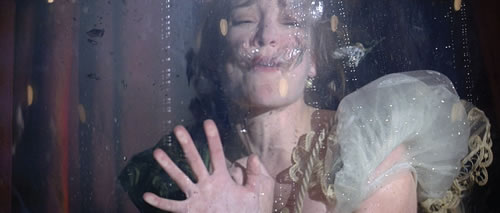
Figure 7.67
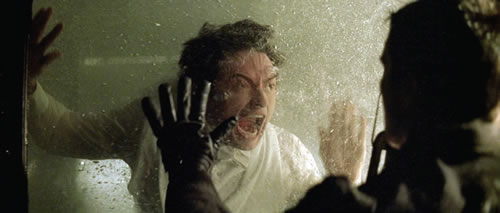
Figure 7.68
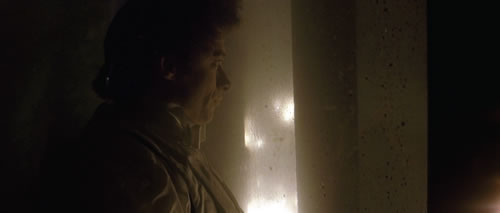
Figure 7.69: The Prestige: The drowning motif. The trauma that sets off Robert‘s obsession: He watches his wife drown in a failed illusion (7.67). In his own version of the Transported Man, Robert drowns every night, replaced by a clone that appears in the auditorium (7.68). One of the sacrificed Roberts is seen submerged in the last shot (7.69).
There are auditory motifs as well. The harsh sound of iron, suggesting an age of lumbering mechanical contraptions, is first heard in the opening, when the top of the tank slams down with a shudder. From then on, we frequently hear rasping metal—chains in Alfred’s prison, the buzzing shock Robert gets from Tesla’s fence, the clank when the Tesla coil is switched off (but not concealing the snick of Robert’s trapdoor), and the groaning spring that locks a dove into a trick apparatus. When Sarah hangs herself, some metallic clashing is heard, and later, when Alfred kneels to his daughter behind prison bars, we see little of his gestures but judge from the frantic clanking of his chains that he’s desperate. This sound motif informs the final sequence, which crosscuts Alfred’s hanging with Robert’s disposal of Tesla’s machine: while Cutter winds a creaking winch, the prisoner’s chains clank and drag as he mounts the gallows.
A less harsh motif dominates the scenes involving Julia’s immersion stunt. When she is first bound and submerged in the tank, a soft snare drum taps out a pulse. Later, when she is tied and can’t escape, the tick of Cutter’s stopwatch takes over the sound track, as if measuring her heartbeat; the sound stops when she is dead. At the film’s climax, when Robert’s opening act is replayed, a similar pulsation is heard in the nondiegetic music as he drowns—creating a parallel to Julia like the one we’ve seen in the images (7.67–7.69).
In many films, parallels are carried by dialogue, and The Prestige makes constant use of recurring lines. Julia says that calling the act The Great Danton is “sophisticated,” and after her death, Robert honors her by using the name: “It’s sophisticated.” Tesla’s remark that “Man’s grasp should exceed his nerve” is modified by Robert as his new tagline: “Man’s reach exceeds his imagination.” The most vivid dialogue motif is probably the one launched by Cutter, when he talks of “getting your hands dirty.” At various points, Cutter and Alfred invoke this line to taunt Robert’s reluctance to risk everything for his magic. At the end, however, confronting Robert’s elaborate revenge scheme, both Alfreds admit that he has finally gotten his hands dirty.
As with other techniques, some of these dialogue motifs not only clarify the story but also drop hints about the mysteries. One striking instance occurs when at the climax we hear the warden intone, “Alfred Borden” during the hanging scene but see the mysterious assistant Fallon making his way to Robert. The juxtaposition prepares us for the unmasking of Fallon as one of the twins. At various points, Robert says that in a disappearing act “no one cares about the man who goes into the box. They care about the man who comes out the other side.” The motif points toward his method of callously killing one version of himself in the Tesla machine so that his double can be reborn elsewhere. The line also anticipates the ending, in which Alfred, apparently hanged, returns home to Jessie and Cutter: He has come out the other side.
Two Journals
The Prestige uses Robert’s and Alfred’s journals to frame certain parts of the past. One man reads the other man’s diary, which will lead us into or out of a flashback. In itself, the diary device is quite familiar, but The Prestige gives it a special emphasis by embedding one diary within another. In the past, Robert acquired Alfred’s notebook, and as he deciphered it, Robert recorded his reactions and memories in his own diary during his trip to Colorado. That diary, which comments on Alfred’s journal, is later read by Alfred in his cell during his trial.
This plot pattern sounds complex, but in fact the embedded diaries help keep us oriented in time, guiding us from present to past and back again. Again, sound plays a crucial role in acclimating us to the device. We hear the diarist’s voice as the reader scans the lines, and this anchors us in two time frames simultaneously.
After the imprisoned Alfred is given Robert’s diary, he starts to read it, and we hear Robert’s voice-over, representing what he has written. “A cipher—an enigma—a search.” The line leads us into the first of several flashbacks to Robert’s trip to Tesla. During that visit to Colorado, Robert begins to decipher Borden’s notebook. Robert’s diary voice-over describes a passage as taking place “just days after he first met me.” This segues into Alfred’s voice-over, representing what Robert has just decoded from the notebook: “We were two young men devoted to an illusion.” The transition to a flashback within a flashback is made clear through the smooth transfers from one voice-over to the next.
The conflict between the men gets sharpened when even the diary entries seem to quarrel. As we see Alfred double over in pain from the botched bullet catch, we hear his diary voice-over explaining that he didn’t really know what knot he had tied to bind Robert’s wife. “I told him the truth” is followed by a cut back to Colorado, showing Robert reading Alfred’s diary as the voice continues: “. . . that I have fought with myself over that night.” Robert looks up from the diary and cries out, “How could he not know?” That external line of dialogue is repeated, but now as a voice-over: “How could he not know?” Cut to Alfred reading the line in his cell. The embedded diaries and blended voice-overs create a tense conversation between the rivals across time and space.
Once the early transitions have established the nested time frames, however, Nolan and Nolan start to shift among them without showing the diaries or employing a voice over. Instead, the voices of Robert and Alfred are used to punctuate certain scenes, supplying private thoughts in the manner of an internal diegetic monologue. For example, on the street, Robert spies on Alfred and his family. Robert’s commentary bursts out, “I saw happiness—happiness that should have been mine.”
Above all, it is Robert’s diary voice-over that helps shift among time frames. His summaries of what he reads in Alfred’s diary substitute for Alfred’s direct voice-over. This prepares us for a surprise when Robert skips to the end of the diary and Alfred’s voice-over returns ominously:
Today Olivia proves her love for me—to you, Angier. Yes, Angier, she gave you this notebook at my request. And Tesla is merely the key to my diary, not to my trick. Did you really think I’d part with my secret so easily, after so much? Good-bye, Angier. May you find solace for your thwarted ambition back in your American home.
But in a film of many parallels, even this mocking challenge is surpassed by another. Alfred, reading Robert’s journal in his cell, confronts this on the last page:
But here, at the turn, I must leave you, Borden. Yes, you, Borden. Sitting there in your cell, reading my diary. Awaiting your death, for my murder.
Alfred is as baffled as we are. How could Robert have known that he would die during the trick and that Alfred would be accused of his murder?
In retrospect, we realize that Robert (the clone who survived that night in the theater but didn’t reveal himself) has prepared the final entry, and perhaps the whole journal, after Alfred’s arrest as a way of tormenting him. The power of these surprises derives from a subtle shift in the voice-over convention. Going beyond simply giving us information, the diary-driven voices have misled us.
Hinting at Secrets
By weaving parallels and journal entries into the plot, the film propels the action forward while enhancing the mysteries. We are continually confronted with new information that has to be fitted into what we have already seen and heard. Yet the film also hints at what is concealed. Most centrally, the secret of both illusions is substitution of a double, and this is suggested by a visual motif. We learn that, since canaries look alike, magicians make canaries vanish and reappear by killing one and substituting another. This is a prototype of Robert’s cloning technique, but it also foreshadows the consequences of the Borden twins’ decision to live out their act, with one eventually sacrificed for the other.
As we’ve seen, hinting occurs throughout the dialogue and the voice-overs. As a single character, Alfred seems contradictory, alternately considerate and brusque. He speaks of having a secret, of being torn in two. His wife, Sarah, says that when he says he loves her, some days he does and some days he doesn’t. In the climactic quarrel between the couple, she says she knows “what you really are,” which panics the cold twin. Perhaps she suspects that there are two Alfreds? Sarah asks if he loves her. “Not today.” She hangs herself.
More subtly, offscreen sound is used to withhold the “Prestige,” or the payoff, of each man’s greatest trick. (Originally, the word prestige meant “illusion,” especially one that dazzles the eyes.) Alfred’s first, minimal version of the Transported Man is shown only in part. We see the setup with Robert watching avidly and Cutter elsewhere in the audience, skeptical. But we don’t see the Prestige phase of the trick. Nolan keeps the camera on Cutter while we hear the second door open and the bouncing ball being caught by the duplicate Alfred. Nolan thereby makes the trick itself vague, to be revealed in full later. Conveying the illusion through offscreen sound also emphasizes the contrasting reactions of Cutter, who is unimpressed, and Robert, who considers it “the greatest magic trick I’ve ever seen.”
Another parallel, then: When Robert demonstrates his Real Transported Man before a world-weary theatrical agent, he vanishes from the stage in jagged blasts of the Tesla coil. The agent protests, “He has to come back. There has to be—” “A Prestige?” says a voice from offscreen. The agent turns automatically to see Robert behind him, stepping down from the back of the balcony. We will see the same stunt presented more fully and with panache in the first performance, but the momentary channeling of story information through the agent emphasizes what Robert values as a performer: watching the viewer’s stunned expression when confronted with what appears to be a miracle.
The Opening
The use of sound to both reveal and conceal story information, in conjunction with other film techniques, comes at the very start of the film. Here sound and image must orient us to the narrative world, introducing the main characters and dramatic issues. The opening must also plant details that may seem unimportant or puzzling but that will later play major roles. The opening of The Prestige also introduces us to one of the film’s major storytelling techniques, that of the voice-over commentary we encounter in the diaries. And some clues tantalize us but become comprehensible once we have penetrated the film’s secrets. Once more, we find that sound assists both clear storytelling and bold misdirection.
The most dramatic portions of the opening involve a performance of Robert’s Tesla-inspired version of the Transported Man. Alfred, disguised in the audience, goes onstage to inspect the gadget and then dodges into the wings and down under the stage. There he finds the tank awaiting Robert. As the trick is consummated, Robert plummets into the water and starts to drown before Alfred’s eyes.
The performance is played with no dialogue, apart from the moment when Alfred assures a stagehand that he’s part of the act. There is a soft but ominous drone from the musical score, overridden by fierce crackling as the Tesla coil fires up. As with the other major illusions, the act’s payoff takes place offscreen; we see the result when Robert falls through the trapdoor. The coil’s crackling and the musical score stop abruptly, in a harsh cutoff that will be typical of the rest of the film, and we hear a splash as Robert is submerged. The top of the tank snaps shut with a whang. Then another long silence, enhancing suspense.
The theater audience stirs restlessly. Where has Robert gone? Meanwhile, below stage, Alfred approaches the drowning Robert, and we hear the heartbeat pulse in the orchestra, foreshadowing Cutter’s ticking stopwatch. As Robert thrashes underwater, the nondiegetic music turns into frantic string twitterings. The image fades to black, the music dies, and the next sequence, at Alfred’s trial, begins.
But this highly dramatic scene, showing a magic trick apparently gone horribly wrong, is crosscut with a more mundane, even trivial moment, taking place in an unidentified time. We see Cutter stroll past a row of cages, select one canary, put it into a cage, and make it disappear. He then makes it reappear to the delight of a little girl. (We’ll later learn that she’s Alfred’s daughter Jessie.) There is no dialogue from within this scene, only the chirping of the birds and the sound of Cutter performing the trick. The tense, somber music starts in this sequence and continues until the moment of Robert’s immersion.
Two magic tricks, one of great simplicity and the other of lethal complexity, are shown in alternation. In three minutes, the film has aroused all manner of questions about what has led up to these events and what will follow. The narration also asks us what connection we are to make between the canary trick and the elaborate stage show. The answer, itself partial and teasing, is provided by a voice-over commentary.
We hear Cutter’s voice explaining that every magic trick has three parts, and his layout of the phases corresponds to both crosscut lines of action. His description of the Pledge, the promise that things work in the ordinary way, is heard in his voice-over as he silently shows Jessie the canary and puts it in the cage. Cut to Robert displaying himself and his machine. Spectators, including Alfred, climb onstage to inspect the gadget.
Then, Cutter explains, comes the Turn, the moment when the ordinary becomes extraordinary. Covering the birdcage with a scarf, he flattens it. Cutter’s commentary coincides with Robert stepping into the electrical field while Alfred explores the trapdoor area below stage. Finally, after the canary and Robert have disappeared, Cutter’s voice-over says:
But you wouldn’t clap yet. Because making something disappear isn’t enough. You have to bring it back. That’s why every magic trick has a third act—the hardest part. The part we call the Prestige.
As we hear these words, we see him showing Jessie the revived canary—a successful feat of legerdemain—crosscut with Robert’s uneasy audience and shots of Alfred staring at Robert struggling underwater.
Cutter’s voice has been closely miked in a dry recording, lending it the sort of intimate, direct-address perspective we’ll encounter in the diary voice-overs. But now, at the fade-out, in a more hollow timbre, another man’s voice repeats, “The Prestige.” As the new scene fades up, Cutter is in the witness box. His dialogue now comes from a more reverberant sound field, suitable to a large courtroom. His voice-over explanation of a trick’s three acts is now motivated as his testimony at Alfred’s trial.
Cutter’s voice-over introduces some central themes, such as the idea that a magic trick has an artistic structure that demands both skill and showmanship—the two features that distinguish Alfred (skill) and Robert (showmanship). Cutter also stresses the need to distract the audience, because, he says, the spectator wants to be fooled. This could be taken as a commentary on our own urge to overlook details in watching the film. And Cutter’s stress on bringing back the vanished object establishes the motif that when the Prestige arrives, no one cares about the man in the box.
In the plot’s overall patterning, Cutter’s commentary establishes the death of Robert as a flashback scene from the present time of the court proceedings. At the film’s close, we learn that the canary trick that Cutter performs is a sort of flashforward, referring to a still later present time enclosing the whole film. The crosscutting has shuttled us between two moments of story time, while the voice-over has put us in yet a third, the court testimony. That testimony is nonsimultaneous with respect to both lines of visual action; it takes place after the death of Robert but long before the scene with Jessie. This opening not only introduces us to major characters and themes but also establishes the time-juggling shifts that we’ll encounter in the film to come.
Cutter’s voice-over prepares us for the tight image/sound synchronization that will carry the plot forward. His voice speaks of showing the Pledge object; he shows the canary; cut to Robert displaying his machine. When Cutter says the object probably isn’t normal, we see Alfred tear off his false beard to prove he’s part of the performance. Cutter explains the second phase, and as his voice says, “The Turn,” cut to Robert literally turning to us. Cutter flattens the birdcage as his voice speaks of the “extraordinary”; cut to Robert galvanized by the Tesla coil.
The commentary drops a few hints, too, as when Cutter indirectly introduces the film’s protagonists (7.70, 7.71). Later, as Alfred prowls in the stage cellar, studying the water tank, Cutter speaks of the audience “not really looking” at what is going on in the trick. Robert plummets into the tank, the lock snaps shut, and Cutter says, “You want to be—” Cut to him snatching the scarf away, showing that the birdcage has vanished as his voice-over finishes: “—fooled.” Indeed, Alfred will be fooled, since he does not understand Robert’s manipulation of his clones until the end. Cutter’s calm delivery about “bringing back” the ordinary object, timed to his presentation of the canary, serves as an upbeat contrast to the stage act. Jessie applauds, but Robert’s audience doesn’t, because the Prestige (“the hardest part”) is missing. Robert, flailing underwater, will not be brought back—at least, not for some time.
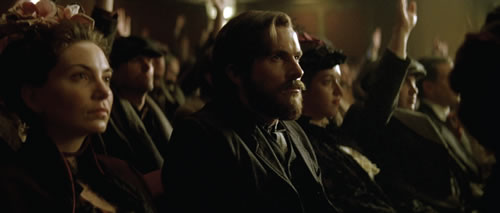
Figure 7.70

Figure 7.71: Cutter introduces the protagonists. As Cutter’s voice-over talks about a magician showing us something ordinary, his mention of “a man” is synchronized with the first shot of Alfred, disguised in the audience (7.70). But Alfred isn’t the man central to the Pledge. That is Robert himself, seen in the next shot (7.71). Along with the editing, the commentary subtly establishes these two as the central antagonists.
This opening could not be as economical and intriguing as it is without Cutter’s voice-over narration. The crosscutting and juxtapositions of dialogue will reappear in the climax and be finally explained in the final shots. Yet there is one more element in the opening passage to consider.
The very first shot of the film fades in on a leftward tracking shot across a field of top hats (7.72). Later we will learn that those are the hats that Tesla has accidentally cloned in his experiments. The next shot shows a row of canaries in cages (7.73); one of these will be the star of Cutter’s trick for Jessie (7.74). In hindsight, we can see that these two shots hint at how both Alfred and Robert accomplish their magic—by using exact copies. In addition, just as a canary has to die in order to disappear, death will haunt each magician’s double. Alfred has given up a great deal for his art, with each twin living only half a life. But Robert has wound up devoting himself to his craft just as passionately. In dying and being reborn every night, he has embraced what Alfred calls “total self-sacrifice.”
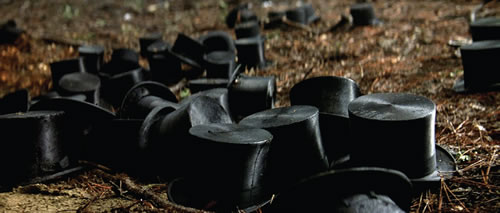
Figure 7.72
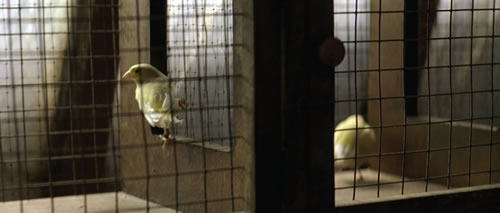
Figure 7.73
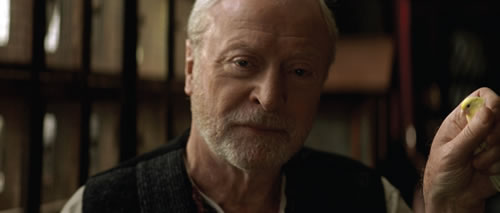
Figure 7.74: Opening hints. In the first shot of The Prestige, the camera tracks over the scattered top hats (7.72). The next shot continues to move along several parakeet cages (7.73), creating a parallel based on the idea of identical copies. Addressing Jessie, Cutter invites us as well to consider how a magic trick may mislead the audience (7.74).
As usual, sound plays a role, too. At three points in the rest of the film, Alfred will ask someone, “Are you watching closely?” It’s his mocking warning that he will
practice some deceptive sleight of hand. At the very start, however, as the camera
coasts over the top hats, we hear this line for the first time. Shifted out of its story position, spoken by a character we don’t yet know, the question becomes a challenge
and warning to the viewer. As a film inviting us to unmask its own legerdemain, The Prestige could just as easily start with the question “Are you listening closely?”
|
|



